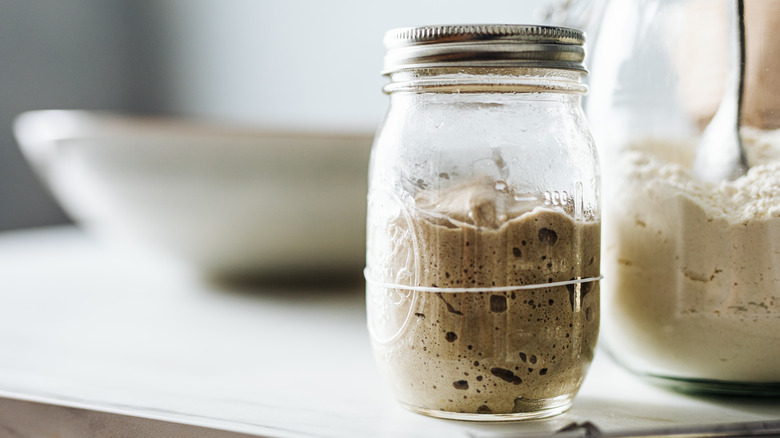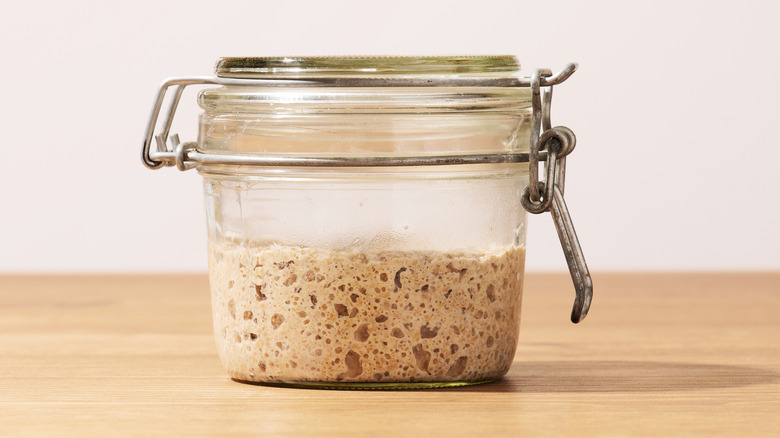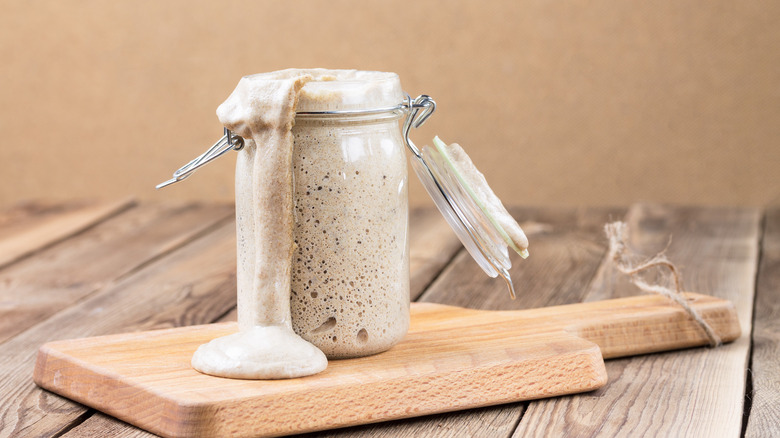How To Tell If Your Sourdough Starter Has Actually Gone Bad
Anyone who wants to witness the intersection of science and magic should look at a sourdough starter. Today, we make our sourdough starters with flour, water, and time — something bakers did thousands of years ago, going back to ancient Egypt. In fact, the world's "oldest" sourdough starter was made with 4,500-year-old yeast. It's wild to think that the sourdough starter in your kitchen is so deeply connected to centuries of bakers. And here's a fun bit of trivia: When a sourdough starter is properly cared for, it can live to be handed down through generations. That might be tricky, but it turns out that killing your starter is really hard to do, too.
If you've thrown your sourdough starter away after leaving it in the back of the fridge for a while or forgetting to feed it a few times, you probably threw away some perfectly good starter. The sludgy, bubbly liquid is surprisingly resilient, and if it's stored properly, it can be revived and used after months of neglect.
That said, it is possible to end up with a sourdough starter that has gone bad and should be thrown away instead of rescued to ruin your favorite sourdough bread recipe. The signs of killing your starter aren't necessarily what you might expect, and if you're experimenting with sourdough, knowing the clues that it's no longer safe to use is crucial.
Signs your sourdough starter has gone bad
In the first few days to around a week-and-a-half, sourdough starter is still developing — and once it's fully mature, it's a pretty hearty substance. However, there are some clues to look for in a starter that mean it's a little too mature.
The development of mold is a sure sign that things have gone from bad to worse. Mold that's black, brown, or green is easy to spot, especially when it starts to develop around the mouth of the jar. But other types of mold and bacterial growths can be harder to see: Some are orange or pink, and they can get lost against the tan, off-white color of the starter. There's a good chance that you stir your starter before using it, and that's a great way to keep an eye on what's going on inside your jar — especially if you haven't paid attention to it in a while.
The other thing that will kill a sourdough starter is if it's exposed to high temperatures. That can mean accidentally turning on the oven if it's stored there or leaving it in direct sunlight for too long. Yeast is pretty hardy at room temperature, but won't survive temperatures over 140 degrees Fahrenheit, so heat will do some serious damage. Were you given a sourdough starter and left it in your hot car for the afternoon? It's probably dead.
Not all funky sourdough starter behavior is bad
Starter is quirky: It'll produce sourdough that tastes different depending on the environment. There are a lot of variables at play in this little ecosystem, and it can do some pretty unusual-looking stuff. That's why it's worth talking about not only how to know it's bad, but about behavior you don't need to worry about.
It's normal for a starter to separate, particularly when it hasn't been fed or stirred in a while. The longer it sits, the more fermentation happens, and when it's not stirred, a liquid will rise to the top. That layer of alcohol — also called hooch — is perfectly normal, even if it's a strange, off-looking color that can range from clear to amber or black. It's also entirely possible that the starter could develop a funky-looking skin on top of the hooch. Strangely, it's probably still fine: Just scrape off the skin, scoop out the starter underneath, and keep going.
It's also a good idea to smell your sourdough starter when you stir it because the presence of moldy odors can indicate that there's trouble brewing. But unusual odors that aren't moldy can be completely normal. If you get a whiff of nail polish remover or alcohol, rotten cheese, or sweaty feet — especially in the early stages — there's no reason to worry.


